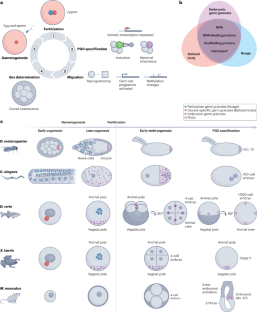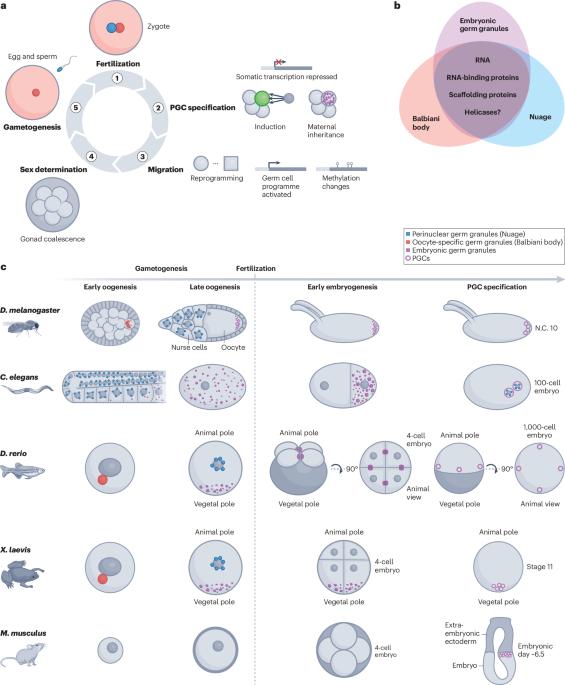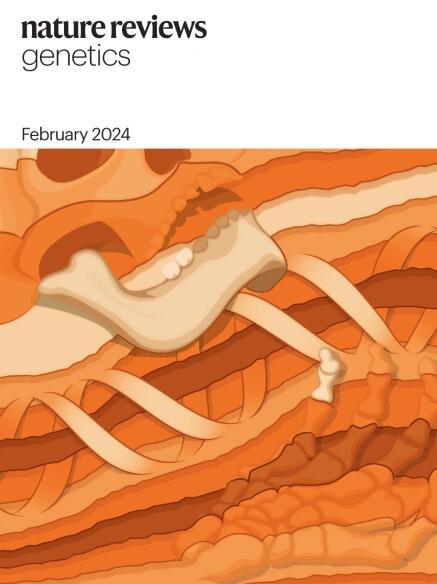生殖颗粒如何促进生殖细胞的命运
IF 52
1区 生物学
Q1 GENETICS & HEREDITY
引用次数: 0
摘要
生殖细胞是人体中唯一能够产生新生物的细胞,这种全能性取决于它们组装无膜生殖颗粒的能力。这些特化的 RNA 和蛋白质复合物是生殖细胞整个生命周期的标志:在晚期卵母细胞和合子中形成胚芽颗粒,在未成熟卵母细胞中形成 Balbiani 体,在成熟配子中形成 nuage。数十年的发育、遗传和生化研究已经确定了胚芽颗粒特有的蛋白质和 RNA 成分,并将其与生殖细胞特性、基因组完整性和配子分化联系起来。现在,新的研究将生殖细胞颗粒定义为通过相分离实现高分子浓缩的生物分子凝聚体,并赋予生殖细胞颗粒在生殖细胞发育不同阶段的不同作用。将生殖细胞胞质组织成细胞亚区似乎不仅对发育中生物体内生殖细胞生命周期的完美连续性至关重要,而且对下一代的成功也至关重要。本文章由计算机程序翻译,如有差异,请以英文原文为准。


How germ granules promote germ cell fate
Germ cells are the only cells in the body capable of giving rise to a new organism, and this totipotency hinges on their ability to assemble membraneless germ granules. These specialized RNA and protein complexes are hallmarks of germ cells throughout their life cycle: as embryonic germ granules in late oocytes and zygotes, Balbiani bodies in immature oocytes, and nuage in maturing gametes. Decades of developmental, genetic and biochemical studies have identified protein and RNA constituents unique to germ granules and have implicated these in germ cell identity, genome integrity and gamete differentiation. Now, emerging research is defining germ granules as biomolecular condensates that achieve high molecular concentrations by phase separation, and it is assigning distinct roles to germ granules during different stages of germline development. This organization of the germ cell cytoplasm into cellular subcompartments seems to be critical not only for the flawless continuity through the germline life cycle within the developing organism but also for the success of the next generation. In this Review, Pamula and Lehmann describe how distinct membraneless germ granules organize the germ cell cytoplasm at different stages of the germline life cycle to determine germ cell identity, maintain genome integrity and regulate gamete differentiation.
求助全文
通过发布文献求助,成功后即可免费获取论文全文。
去求助
来源期刊

Nature Reviews Genetics
生物-遗传学
CiteScore
57.40
自引率
0.50%
发文量
113
审稿时长
6-12 weeks
期刊介绍:
At Nature Reviews Genetics, our goal is to be the leading source of reviews and commentaries for the scientific communities we serve. We are dedicated to publishing authoritative articles that are easily accessible to our readers. We believe in enhancing our articles with clear and understandable figures, tables, and other display items. Our aim is to provide an unparalleled service to authors, referees, and readers, and we are committed to maximizing the usefulness and impact of each article we publish.
Within our journal, we publish a range of content including Research Highlights, Comments, Reviews, and Perspectives that are relevant to geneticists and genomicists. With our broad scope, we ensure that the articles we publish reach the widest possible audience.
As part of the Nature Reviews portfolio of journals, we strive to uphold the high standards and reputation associated with this esteemed collection of publications.
 求助内容:
求助内容: 应助结果提醒方式:
应助结果提醒方式:


